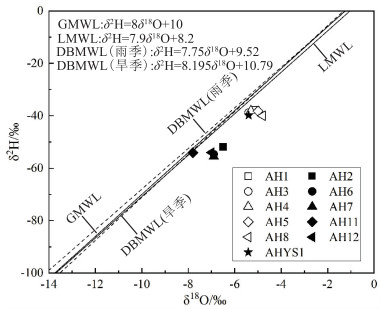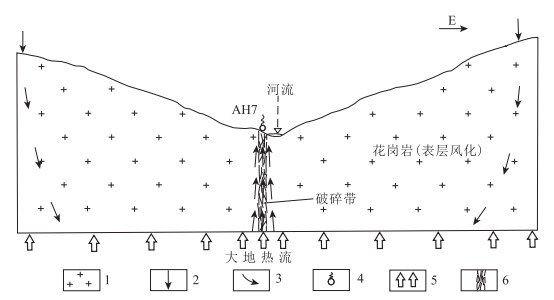Hydrochemical and isotopic characteristics and formation of the hot spring in the Dabie Mountain area,Anhui Province
-
摘要:
安徽大别山区位于扬子板块和中朝板块之间的碰撞造山带东部, 南东侧以池-太断裂为界, 北西侧止于金寨深断裂, 向东至庐江东汤池。对大别山区5个温泉, 即太湖县汤泉乡汤湾温泉(AH2)、岳西县温泉镇温泉(AH6)、岳西县菖蒲镇溪沸温泉(AH7)、庐江县东汤池温泉(AH11)和舒城县西汤池温泉(AH12)进行调查和分析。深大断裂和与之平行或斜交的小型断裂控制着大别山区温泉的出露, 地下热储带分布于花岗岩和变质花岗岩中。温泉水温为40~70℃, pH值为7~8.8, 均为中低温、弱碱性温泉。温泉氢氧稳定同位素组成表明, 大别山区温泉的补给水源为大气降水, 并具有轻微的18O漂移现象。利用同位素高程效应公式估算温泉补给区高程为950~1300 m, 补给区平均温度约为8.2℃。地下水在大别山区接受大气降水入渗补给, 经历深循环受到来自深部热源的加热之后, 沿断裂带或破碎带上升, 在山谷、河谷的低处出露形成温泉。估算的热储温度为80~120℃, 热水循环深度为1400~1800 m。结合硅焓方程法和实地调查, 认为AH2和AH7不存在冷热水混合, AH6、AH11和AH12若继续扩大开采, 不排除会发现热水与浅部冷水的混合。
Abstract:The Dabie Mountain area in Anhui is located in the eastern part of the collision orogenic belt between the Yangtze Plate and China-Korea continental Plate.The southeast side is bounded by the Chi-Tai fault, the northwest side ends by the Jinzhai deep fault, and east side to East Tangchi in the Lujiang.Five hot springs in the Dabie Mountain area including the Tangwan hot spring(AH2)in Tangquan Township of Taihu County, Wenquan Town hot spring(AH6)in Yuexi County, Xifei hot spring(AH7)in Changpu Town of Yuexi County, East Tangchi hot spring(AH11)in Lujiang County and West Tangchi hot spring(AH12)in Shucheng County are investigated.Deep and large faults and small parallel or oblique faults control the occurrence of the hot springs in the study area, and underground heat storage zones exist in the granite and metamorphism granite.The water temperature of hot springs in the study area ranges from 40~64℃, and the pH value, from 7 to 8.8.The hot springs are of medium-low temperature and are weakly alkaline hot springs.The stable isotope compositions of hydrogen and oxygen of the hot springs indicates that the hot springs in the Dabie Mountains area are of meteoric origin and have a slight 18O shift.Based on altitude effect, the elevations of recharge areas of the hot springs are estimated to be about 600~900 m, and the average temperature of the recharge areas is about 8.2℃.After receiving recharge from infiltration of precipitation in the Dabie Mountain area, groundwater is heated by heat flow from below during deep circulation, then rises to the surface along fault zones or fracture zones, and emerges in the form of hot springs in the lower parts of valleys and river valleys.The estimated temperatures of the geothermal reservoirs are 80~120℃, and the circulation depth of hot water, 1400~1800 m.The results with silicon enthalpy equation method and field investigation, indicate that there is no mixing of hot and cold water in hot springs AH2 and AH7.If hot springs AH6, AH11 and AH12 are exploited continually, mixing of hot water and shallow cold water will be expected.
-

-
图 1 安徽大别山区地质略图(据参考文献[18]修改)
Figure 1.
表 1 安徽大别山区温泉的补给高程
Table 1. Estimated altitude of the recharge areas of the hot springs in the Dabie Mountain area, Anhui Province
温泉名称 水样编号 δ12H/‰ δ18O/‰ 标高/m 中国地区高程效应关系 中国东部地区高程效应关系 公式(1) 公式(2) 公式(3) 汤湾温泉 AH2 -51.9 -6.5 80.0 1010.7 903.0 420.0 温泉镇温泉 AH6 -54.7 -6.9 408.0 1554.15 1111.9 553.3 溪沸温泉 AH7 -55.6 -6.9 120.0 1335.4 1179.1 553.3 东汤池温泉 AH11 -54.1 -7.8 40.0 1140.0 1067.2 853.3 西汤池温泉 AH12 -54.0 -7.0 100.0 1192.3 1059.7 586.7 表 2 安徽大别山区温泉的补给区温度
Table 2. Estimated temperature of the recharge areas of the hot springs in the Dabie Mountain area, Anhui Province
温泉名称 水样编号 δ2H
/‰δ18O
/‰补给温度/℃ 公式(4) 公式(5) 公式(6) 汤湾温泉 AH2 -51.9 -6.5 10.2 8.6 22.1 温泉镇温泉 AH6 -54.7 -6.9 9.6 8.1 19.8 溪沸温泉 AH7 -55.6 -6.9 9.6 7.9 19.8 东汤池温泉 AH11 -54.1 -7.8 8.3 8.2 14.7 西汤池温泉 AH12 -54 -7 9.5 8.2 19.3 表 3 安徽大别山区温泉镭-氡法年龄估算结果
Table 3. Estimated age of the hot springs in the Dabie Mountain area, Anhui Province
温泉名称 水样编号 222Rn
/(Bq·L-1)226Ra
/(Bq·L-1)年龄/a 汤湾温泉 AH2 0.024 0.004 427.98 温泉镇温泉 AH6 0.01 0.002 523.81 溪沸温泉 AH7 0.079 0.002 60.19 东汤池温泉 AH11 0.052 0.02 1139.69 西汤池温泉 AH12 0.03 0.003 247.33 表 4 安徽大别山区温泉热储温度估算结果
Table 4. Estimated temperature of the hot springs in the Dabie Mountain area, Anhui Province
温泉名称 水样编号 水温/℃ 计算热储温度/℃ 估算热储温度/℃ 公式(8) 公式(9) 公式(10) 公式(11) 公式(12) 汤湾温泉 AH2 46.3 110.48 110.16 109.75 59.63 80.89 80~110℃ 温泉镇温泉 AH6 51 120.46 120.24 118.36 69.61 91.83 91~120℃ 溪沸温泉 AH7 40 109.43 109.1 108.84 58.59 79.74 79~109℃ 东汤池温泉 AH11 61.3 122.23 122.02 119.88 71.38 93.79 93~122℃ 西汤池温泉 AH12 64 121.05 120.84 118.87 70.2 92.49 89~121℃ 表 5 温泉循环深度计算结果
Table 5. Estimated circulation depth of the hot springs
温泉名称 水样编号 G/
(m·℃-1)Tz/℃ T0/℃ Z0/m Z/m 汤湾温泉 AH2 20 95 15 20 1620 温泉镇温泉 AH6 20 90 15 20 1520 溪沸温泉 AH7 20 85 15 20 1420 东汤池温泉 AH11 10 105 15 20 1820 西汤池温泉 AH12 20 100 15 20 1720 -
[1] 周训, 金晓媚, 梁四海, 等.地下水科学专论(第二版) [M].北京:地质出版社, 2017.
[2] Fournier R O. Chemical geothermometers and mixing models for geothermal systems[J]. Geothermics, 1977, 5(1/4) : 41-50.
[3] Giggenbach W F, Minissale A A, Scandiffio G. Isotopic and chemical assessment of geothermal potential of the Colli Albani area, Latium region, Italy[J]. Applied Geochemistry, 1988, 3(5) : 475-486. doi: 10.1016/0883-2927(88)90020-0
[4] Asta M P, Gimeno M J, Luis F, et al. Hydrochemistry and geothermometrical modeling of low-temperature Panticosa geothermal system(Spain) [J]. Journal of Volcanology & Geothermal Research, 2012, 235/236: 84-95.
[5] Lambrakis N, Kallergis G. Contribution to the study of Greek thermal springs: hydrogeological and hydrochemical characteristics and origin of thermal waters[J]. Hydrogeology Journal, 2005, 13(3) : 506-521. doi: 10.1007/s10040-004-0349-x
[6] Chatterjee S, Sinha U K, Deodhar A S, et al. Isotope-geochemical characterization and geothermometrical modeling of Uttarakhand geothermal field, India[J]. Environmental Earth Sciences, 2017, 76(18) : 638. doi: 10.1007/s12665-017-6973-2
[7] 陈墨香. 中国地热资源的分布及其开发利用[J]. 资源科学, 1991, 13(5) : 40-46. https://www.cnki.com.cn/Article/CJFDTOTAL-ZRZY199105006.htm
[8] 汪集旸, 熊亮萍, 庞忠和. 中低温对流型地热系统[M]. 北京: 科学出版社, 1993.
[9] 周训, 陈明佑, 李慈君. 深层地下热水运移的三维数值模拟[M]. 北京: 地质出版社, 2001.
[10] 周海燕, 周训, 柳春晖, 等. 广东省从化温泉热矿水水化学与同位素特征[J]. 自然资源学报, 2008, 23(4) : 155-162. https://www.cnki.com.cn/Article/CJFDTOTAL-ZRZX200804017.htm
[11] 谭梦如, 周训, 张彧齐, 等. 云南勐海县勐阿街温泉水化学和同位素特征及成因[J]. 水文地质工程地质, 2019, 46(3) : 74-84. https://www.cnki.com.cn/Article/CJFDTOTAL-SWDG201903010.htm
[12] 张七道, 刘振南, 尹林虎. 深变质岩区地热流体化学特征及成因-以滇西陇川盆地温泉为例[J]. 吉林大学学报(地球科学版), 2021, 51(6) : 1838-1852. https://www.cnki.com.cn/Article/CJFDTOTAL-CCDZ202106018.htm
[13] 柯柏林, 林天懿, 李文, 等. 北京西山谷积山背斜地热系统成因模式及远景区预测[J]. 地质通报, 2019, 38(8) : 1378-1385. https://www.cgsjournals.com/article/id/6153fe89ed73f876a05b5e40
[14] 吴海权, 杨则东, 疏浅, 等. 安徽省地热资源分布特征及开发利用建议[J]. 地质学刊, 2016, 40(1) : 176-182. https://www.cnki.com.cn/Article/CJFDTOTAL-JSDZ201601023.htm
[15] 潘国林. 安徽省地热资源特征及远景区划[J]. 中国地质灾害与防治学报, 2011, 22(2) : 130-134. https://www.cnki.com.cn/Article/CJFDTOTAL-ZGDH201102026.htm
[16] 程长根, 杨立本. 安庆市地热水资源分布特征与开发利用初步研究[J]. 安徽地质, 2005, 15(3) : 186-189.
[17] 安徽省地质调查院. 安徽省太湖幅1: 25万区域地质调查[M]. 北京: 地质出版社, 2006.
[18] 徐树侗, 江来利. 大别山区(安徽部分) 的构造格局和演化过程[J]. 地质学报, 1992, 66(1) : 1-14. https://www.cnki.com.cn/Article/CJFDTOTAL-DZXE199201000.htm
[19] 彭吟雪. 安徽省地下热水水化学和环境同位素特征及成因研究[D]. 合肥工业大学硕士学位论文, 2016.
[20] 安徽省地质矿产局. 安徽省区域地质志[M]. 北京: 地质出版社, 1987.
[21] 杨义忠, 王徽, 蔡杨, 等. 北淮阳东段西汤池岩体地球化学特征、锆石U-Pb定年及成因[J]. 地质学刊, 2018, 42(2) : 187-196. https://www.cnki.com.cn/Article/CJFDTOTAL-JSDZ201802002.htm
[22] 杜建国. 大别造山带中生代岩浆作用与成矿地球化学研究[D]. 合肥工业大学博士学位论文, 2000.
[23] 中华人民共和国地质矿产部. 水中氢同位素锌还原法测定(DZ/T0184.19—1997) [S]. 北京: 中国标准出版社, 1997.
[24] 中华人民共和国地质矿产部. 天然水中氧同位素二氧化碳- 水平衡法测定(DZ/T0184.21—1997) [S]. 北京: 中国标准出版社, 1997.
[25] 钱会, 马致远, 李培月, 等. 水文地球化学[M]. 北京: 地质出版社, 2005.
[26] 王恒纯. 同位素水文地质概论[M]. 北京: 地质出版社, 1991.
[27] 王泽龙. 北京市小汤山地区地温场特征及地下热水成因模式分析[D]. 中国地质大学(北京) 硕士学位论文, 2007.
[28] 卞跃跃, 赵丹. 四川康定地热田地下热水成因研究[J]. 地球学报, 2018, 39(4) : 109-115. https://www.cnki.com.cn/Article/CJFDTOTAL-DQXB201804012.htm
[29] Craig H. Isotopic Variations in Meteoric Waters[J]. Science, 1961, 133(3465) : 1702-1703.
[30] 郑淑蕙, 侯发高, 倪葆龄. 我国大气降水的氢氧稳定同位素研究[J]. 科学通报, 1983, 28(13) : 801-801. https://www.cnki.com.cn/Article/CJFDTOTAL-KXTB198313010.htm
[31] 张蓓蓓, 徐庆, 姜春武. 安庆地区大气降水氢氧同位素特征及水汽来源[J]. 林业科学, 2017, 53(12) : 20-29. https://www.cnki.com.cn/Article/CJFDTOTAL-LYKE201712003.htm
[32] 马致远, 吴敏, 郑会菊, 等. 对关中盆地腹部深层地下热水δ18O富集主控因素的再认识[J]. 地质通报, 2018, 37(2/3) : 487-495. https://www.cgsjournals.com/article/id/6153fe9eed73f876a05b5e91
[33] 于津生, 虞福基, 刘德平. 中国东部大气降水氢、氧同位素组成[J]. 地球化学, 1987, 16(1) : 24-28. https://www.cnki.com.cn/Article/CJFDTOTAL-DQHX198701002.htm
[34] Dansgaard W. Stable isotopes in precipitation[J]. Tellus, 1964, 16(4) : 436-468.
[35] Cherdyntsev V V. Uranium-234[M]. Jerusalem: Keter Press, 1971.
[36] 王莹, 周训, 于湲, 等. 应用地热温标估算地下热储温度[J]. 现代地质, 2007, 21(4) : 605-612. https://www.cnki.com.cn/Article/CJFDTOTAL-XDDZ200704003.htm
[37] 单玄龙, 蔡壮, 郝国丽, 等. 地球化学温标估算长白山地热系统热储温度[J]. 吉林大学学报(地球科学版), 2019, 49(3) : 662-672. https://www.cnki.com.cn/Article/CJFDTOTAL-CCDZ201903004.htm
[38] Fournier R O, Potter R W Ⅱ. A revised and expanded silica(quartz) geothermometer[J]. Geothermal Resources Council Bulletin, 1982, 11(6) : 3-12
[39] Fournier R O, Truesdell A H, Calif M P. Geochemical indicators of subsurface temperature-part 2, estimation of temperature and fraction of hot water mixed with cold water[J]. Journal of Research U.S. Geological Survey, 1974, 2(3) : 263-270.
[40] 林元武. 红河断裂带北段温泉水循环深度与地震活动性的关系探讨[J]. 地震地质, 1993, (3) : 193-206. https://www.cnki.com.cn/Article/CJFDTOTAL-DZDZ199303000.htm
[41] 苏贵芬, 李方根, 韩晓南. 安徽皖南地区构造盆地及深大断裂地热潜力研究[J]. 中外能源, 2018, 23(7) : 15-24. https://www.cnki.com.cn/Article/CJFDTOTAL-SYZW201807003.htm
[42] Liu Y P, Zhou X, Fang B, et al. A preliminary analysis of the formation of travertine and travertine cones in the Jifei hot spring, Yunnan, China[J]. Environmental Earth Sciences, 2012, 66(7) : 1887-1896.
-




 下载:
下载:



